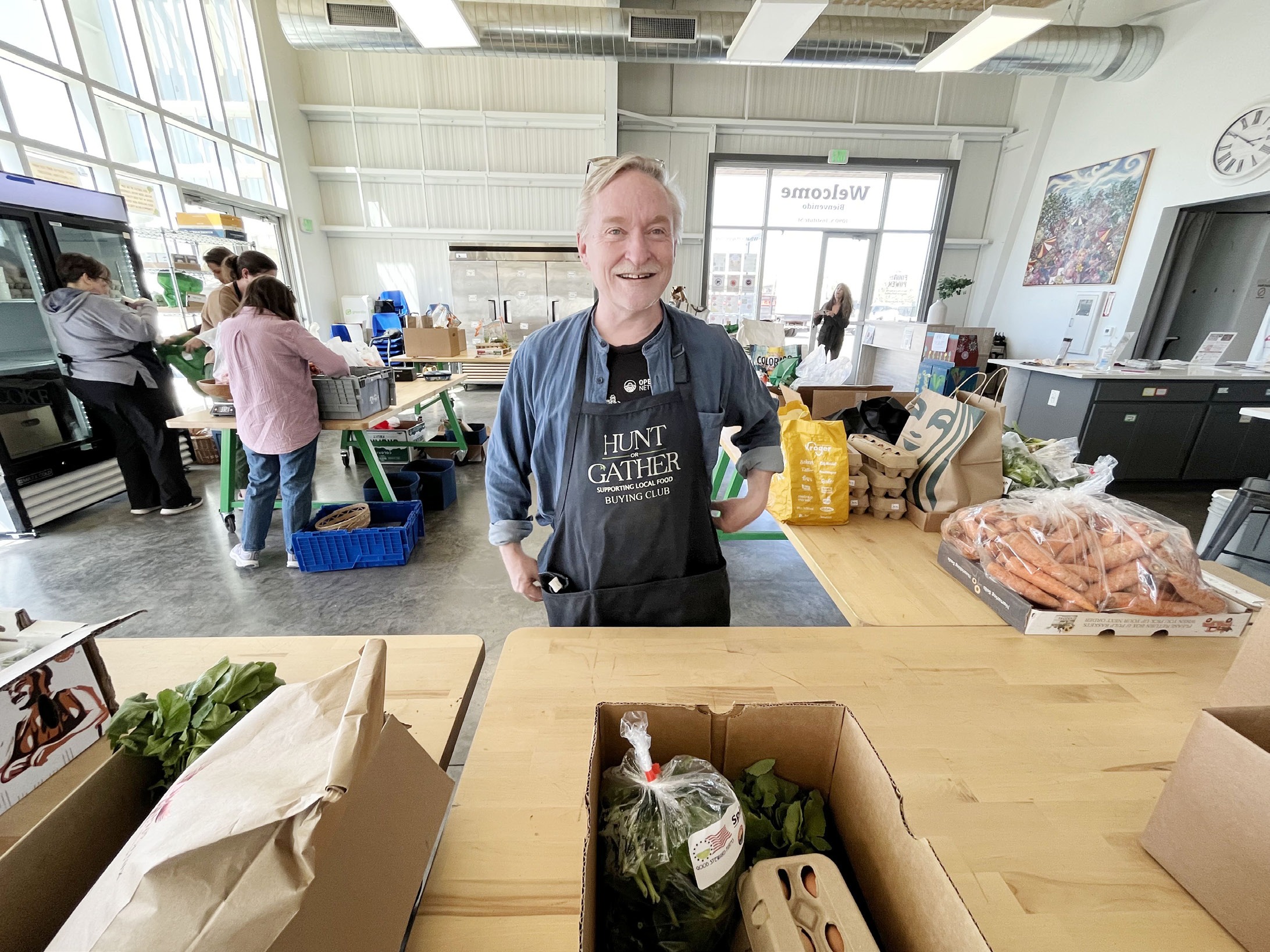Megan Andreozzi-Harris studied anthropology because she loved to travel, but equally important to her was developing personal connections and roots in a local community. As she got deeper into the profession, she realized researchers in her field often traveled for months at a time studying in foreign countries.
“That’s just not really conducive for setting roots in a community where you’re making a change,” she said.
It was this disconnect with her chosen career that led her into local food and agriculture, onto farms, and promoting local food systems.
Nearly 13 years ago, with assistance from the Pikes Peak Community Foundation, Andreozzi-Harris began running a store in the Ivywild neighborhood to promote locally produced Colorado food. From these efforts and connections came Hunt or Gather.
Hunt or Gather is a buying club providing wholesale food pricing from local Colorado farmers and producers, many of whom grow regeneratively and organically. It provides farmers a more predictable and efficient means to get their products to the public, who can benefit from fresh food. Many smaller farms often can’t get into large grocery chains because of the volume requirements, fees, and year-round seasonal demand that many contracts command. Because of this, Hunt or Gather has filled a critical gap in this systemic issue.
You have an understanding and connection with the planet that’s very different. – Megan Andreozzi-Harris
Over the years, Andreozzi-Harris and a small team of volunteers have run the organization out of her garage, out of parking lots of supportive businesses, and, currently, out of Food to Power in the Hillside neighborhood. The organization is funded through yearly membership fees and a 10% administrative fee built into the pricing of all sold items. The fee goes towards the Open Network, a donation-based online platform designed for farmers and local producers, which hosts Hunt or Gather’s sales online. There is no minimum order, cash and checks are accepted, but there is a 2.6% credit card processing fee. A yearly membership fee begins at $50 in year one, decreasing to $25 after that. Currently, they have around 150 paying members. During growing seasons, they also promote local CSAs from the likes of Frost Farms, Mountain Freshies, Valley Roots, and New Roots Farm.
During winter and spring periods, deliveries are hosted every two weeks, generally on a Wednesday or Thursday. During the summer and fall, it’s weekly. During pick-up week, a few hours before opening, a handful of volunteers gather at the Food to Power to unload the food trucks and assemble orders.
On a Thursday in mid-April, around 35 people came to pick up their orders. On the tables, each person’s order was personally labeled. In the middle of the set up, farmer Susan Gordon, who runs New Roots Farm in Canon City, was sorting out her carrots, stopping intermittently to greet familiar faces. From 3 p.m. on, members trickled in, often greeted by name, sticking around to catch up with old friends. At one point, a woman came in with her baby, who promptly proceeded to steal the show.

Orders included an assortment of fresh, Colorado-grown vegetables like spinach, arugula, carrots, radishes, and potatoes. I picked up my 10-pound burlap bag of Anasazi beans courtesy of the Adobe Milling company in Dove Creek, Colo. There were some extra eggs and russet potato “seconds” – produce that is less photogenic but just as healthy – which I also claimed for $6 and 50 cents a pound respectively. I was encouraged by multiple volunteers to freely sample some of Gordon’s fantastically sweet carrots – and I did buy a few extra to add to my order.
Other offerings throughout the year include locally baked bread and pastries, meat, fruit, microgreens, grains, flour, cheese, nuts and other snacks. In May, New Roots Farm even offered tomato and herb seedlings. The vast majority were from Colorado, though there were a couple of items from Kansas and Montana. Most produce items are offered in bulk quantities, though each cycle “splits” (or smaller versions of bulk items) are offered as well. Members are encouraged to share larger orders with other friends and family.
For all the volunteers I met, there was a palpable passion in conducting this most basic of human necessities.
Matt Noyes was one of the regular crew of volunteers present. Like his fellow crew members, he proudly sported an official Hunt or Gather apron.
For Noyes, Hunt or Gather has been a good way to coordinate the ordering and distribution of local food in the face of an increasingly impersonal food system. It was important to him to have a sense of connection not only with consumers but also the growers themselves.
“I really enjoy being part of the actual process,” he said. “It represents an effort to organize your food system differently without all the massive industrial agriculture, the incredible mileage involved in the transportation of food.”
Jenileigh Harris has been volunteering with Hunt or Gather for the last couple of years. She is also the operations director at the Artisan Grain Collaborative, working with local producers in the grain industry. Her involvement was a way to be present in the things she had already been supporting in other areas of her life.
“I was feeling this need to do the physical work and show up and be in space with people working on this stuff,” she said.
For Harris and the rest of the team, encouraging participation in the local food system was just as important as eating flavorful, delicious good food.
“We want folks who are buying this food to be part of getting the food and not just a way-distant consumer on the other end,” she said. “If we want to get this good local food, then we have to organize it ourselves. We have to build these relationships with the distributors and farmers and get it here and do the work to make these connections possible.”
For Andreozzi-Harris, Hunt or Gather’s work in addressing issues with the current heavily centralized food system has come with a profound sense of purpose.
“I know every single member. I know their families. The same with the farmers. I know we are a lifeline to some degree for many of them with the work we do with CSAs and supporting them that way, but we’re also some of their biggest buyers. That’s life-changing,” she said.
It has also brought a greater appreciation for the seasons and food that runs contrary to the ultra-processed, convenience-driven food culture in our modern society. Not only does the buying club eliminate the temptation to buy packaged junk food, but it encourages its members to know what’s in season and what is grown in their backyard.
“You have an understanding and connection with the planet that’s very different than ‘I want whatever I want when I want it,'” she said.
With this awareness comes a direct acknowledgement of the farmers who grow it, cultivating a relational attitude towards food instead of strictly a transactional one. It is a model that reinforces the sacrifice the farmers make to raise good food regeneratively and the intentionality required of the consumer to set aside a weekly time to meet them where they’re at.
“We’ve created a society where we want this, this, this, this, this, and here,” said Andreozzi-Harris, “[At Hunt or Gather], the connection that you see with people when the farmers are there, the gratitude and the conversation about families and health – I see it every day when we run those pickups – that connection to me is very valuable.”
To sign up, visit Openfoodnetwork.net/horg/shop#/contact_panel.

